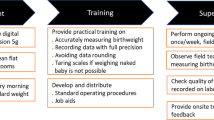Abstract
Objective
To field test the Individualised Color Coded Any Day (ICCAD) growth monitoring charts at primary health care level in three districts of Maharashtra.
Methods
The present study was conducted in three districts of Maharashtra – Pune, Satara and Kolhapur and included newborns with weight ≥ 1500 g born during 1st May 2010 to 30th July 2011. Talukas were matched based on mortality and coverage indicators and put in study (ICCAD use) and control area (ICCAD non-use) from every District. Health centres were selected from each taluka where facilities of expert obstetric and pediatric services did not exist but number of deliveries conducted was high. Data was collected during neonatal period. Three patterns of ICCAD charts; 1500 g to 1999 g, 2000 to 2499 g and ≥2500 g; developed from daily weight record of 430 newborns for 30 d were used. Outcome measures were neonatal mortality rate (NMR) and weight gain in study and control groups.
Results
There were 6705 live births from study and 6341 from control area. The NMR of study area (6.3/1000 live births) was significantly lesser as compared to control area (10.6/1000 live births). Birth weight group specific NMR of birth weight between 1500 to <2000 g and ≥2500 g was significantly lower in study area as compared to control area. There was improvement in mean gain weight of 15 g, 43 g and 89 g for respective birth weight groups in ascending order.
Conclusions
This innovative appropriate technological tool based on translational research of ICCAD neonatal growth monitoring charts appears to have benefited the decision of type of care.



Similar content being viewed by others
References
Neonatal and Perinatal Mortality Country, Regional and Global Estimates, WHO 2006. Available at: http://whqlibdoc.who.int/publications/2007/9789241596145_eng.pdf. Accessed on 10th Oct 2015.
Park K. Neonatal mortality rate. In: Park N, editor. Preventive medicine in obstetrics, paediatrics and geriatrics, preventive and social medicine. 21st edition. Jabalpur: Banarsidas Bhanot; 2011. p. 521.
Siddharth Ramji. Newborn and child health in India: problems and interventions. NCMH Background Papers-Burden of Diseases in India. Available at: http://whoindia.org/LinkFiles/Commision_on_Macroeconomic_and_Health_Bg_P2__Newborn_and_child_health_in_India.pdf. Accessed on 10th Oct 2015.
Govt. of India. Ministry of Health and Family Welfare. Integrated management of neonatal and childhood illness. Physician chart booklet. Growth chart from birth to 5 years of age graph. UNICEF: WHO Child and Adolescent and Development (CAH); 2008.
Govt. of India. Ministry of Health and Family Welfare. Integrated management of neonatal and childhood illness. Physician chart booklet. Young infant age up to 2 months graph. UNICEF: WHO Child and Adolescent and Development (CAH); 2008.
Pratinidhi AK, Shrotri AN, Shah U. Risk approach and intervention strategy in MCH care. Indian J Comm Med. 1990;1:56–60.
Pratinidhi AK, Kakade SV, Pawar SD, et al. Individualized color coded any day neonatal growth monitoring charts for primary health care workers: a new approach. NHL J Med Sci. 2015;4:17–26.
SHSRC Maharashtra. Health Status Maharashtra 2010, NRHM, Mortality Statistics: 15
Dept. of Reproductive Health and Research. Kangaroo mother care: a practical guide. Geneva: WHO; 2003.
Acknowledgments
The authors are thankful to Dr. Satish Pawar, Director of Health Services for the permission and cooperation to work in rural health centres of three districts of Maharashtra. They are thankful to Dr. Jayshree Patkar, Dr. Usha Mane, Dr. S.D. Kulkarni, research officers appointed for the project and for field work and supervision of work done by ANMs.
Contributions
AKP: Original idea of appropriate technological tool of growth monitoring charts, study design, supervision and paper writing; PPD: Fine tuning of neonatal growth monitoring charts, study design and paper writing; SVK: Preparation of growth monitoring charts and statistical analysis; CDA, SYI, SSP and SVP: Training of doctors and nurses and supervision of field work. AKP will act as guarantor for the paper.
Author information
Authors and Affiliations
Corresponding author
Ethics declarations
Conflict of Interest
None.
Source of Funding
National Rural Health Mission, Maharashtra, Govt. of Maharashtra approved the research proposal entitled ‘Field Testing of Appropriate Technology Tools for monotoring of slow progress of labour and growth of LBW babies below 2500 g at PHC/RH level’. Fund released of Rs. 15,00,000/− for the same.
Rights and permissions
About this article
Cite this article
Pratinidhi, A.K., Doke, P.P., Kakade, S.V. et al. Field Testing of Appropriate Technological Tool of Individualised Color Coded Any Day Neonatal Growth Monitoring Charts for Neonatal Care at Primary Health Care Level. Indian J Pediatr 83, 650–656 (2016). https://doi.org/10.1007/s12098-015-2027-5
Received:
Accepted:
Published:
Issue Date:
DOI: https://doi.org/10.1007/s12098-015-2027-5




